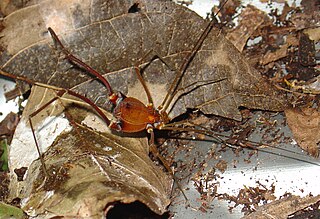
The Opiliones are an order of arachnids colloquially known as harvestmen, harvesters, harvest spiders, or daddy longlegs. As of April 2017, over 6,650 species of harvestmen have been discovered worldwide, although the total number of extant species may exceed 10,000. The order Opiliones includes five suborders: Cyphophthalmi, Eupnoi, Dyspnoi, Laniatores, and Tetrophthalmi, which were named in 2014.

Lacronia is a genus of South American harvestmen, which includes four Brazilian species. A striking diagnostic character is the trochanter IV of male with strong medial prolateral apophysis forming a pincer with the dorso-apical apophysis of coxa IV.

Gonyleptoidea is the most diverse superfamily of the Grassatores. It includes around 2,500 species distributed in the Neotropics. They are characterized by the simplified male genitalia, with the glans free subapical in the truncus.

Cosmetidae is a family of harvestmen in the suborder Laniatores. With over 700 species, it is one of the largest families in Opiliones. They are endemic of the New World with a Nearctic-Neotropical distribution where a large fraction of the diversity of Opiliones are represented by this single family. Cosmetidae have the northern extent of their range into the USA, where a small number species occur in the southern states. However, the family is especially diverse in Mexico, Central America and northern South America; especially the Andean realms. Their range also extends further south into Argentina and southern Brazil, but they are absent in Chile. Cosmetidae are prevalent in Amazonian region, but only relatively few also occur in Brazilian Atlantic Forest. Several species are also found in the Caribbean.

The Sclerosomatidae are a family of harvestmen with about 1,300 known species. One former subfamily has been recently removed to form a new family, Globipedidae.

The Triaenonychidae are a family of harvestmen with about 120 genera and more than 440 described species.
The Stygnidae are a family of neotropical harvestmen within the suborder Laniatores.
Agoristenidae are a neotropical harvestman family of the Suborder Laniatores, in the superfamily Gonyleptoidea.
The Manaosbiidae are a family of neotropical harvestmen within the suborder Laniatores.
Kimulidae is a small neotropical family of the harvestman infraorder Grassatores with about thirty described species.
Paratamboicus was a genus of harvestmen in the family Sclerosomatidae from the Americas, described by Mello-Leitão 1940 with the type-species by original designation being Paratamboicus bicornutus Mello-Leitão, 1940. It was much later considered as Junior subjective synonym of Holcobunus Roewer 1910 by Tourinho & Kury (2001).
Caelopyginae is a neotropical sub-family of harvestmen in the family Gonyleptidae.
Zalmoxis is a genus of harvestmen, within the Zalmoxidae family. They are found in tropical Australia, Borneo, New Guinea, the Philippines and on Pacific islands.
Taito is a genus of harvestmen in the family Cosmetidae. The genus is endemic to the Amazon Basin in Brazil, Colombia, Ecuador and Peru.
Metasarcidae is a family of harvestmen, first described by Adriano B. Kury in 1994.
Holcobunus is a genus of the order Opiliones in the family Sclerosomatidae. The genus was first described by Roewer, 1910





